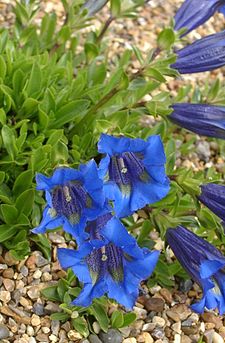- Gentianidae
-
?Genciánidas
Gentiana acaulis (Gentianaceae) Clasificación científica Reino: Plantae Clados superiores: Archaeplastida
Viridiplantae
Streptophyta
Streptophytina
Embryophyta
Tracheophyta
Euphyllophyta
Lignophyta
SpermatophytaDivisión: Angiospermae Clase: Eudicotyledoneae Clados y órdenes[2] - Gentianidae W.S. Judd, D.E. Soltis & P.S. Soltis,[1]
- clado Lámidas
- familia Boraginaceae -- Sin circunscribir a ningún orden
- familia Vahliaceae -- Sin circunscribir a ningún orden
- familia Icacinaceae -- Sin circunscribir a ningún orden
- familia Metteniusaceae -- Sin circunscribir a ningún orden
- familia Oncothecaceae -- Sin circunscribir a ningún orden
- orden Garryales
- orden Gentianales
- orden Lamiales
- orden Solanales
- clado Campanúlidas
- orden Apiales
- orden Aquifoliales
- orden Asterales
- orden Bruniales
- orden Dipsacales
- orden Escalloniales
- orden Paracryphiales
En Nomenclatura filogenética, las genciánidas (Gentianidae) son un grupo de eudicotiledóneas que habían sido nombradas informalmente como «euastéridas»[3] [4] [5] o «núcleo de las astéridas».[6] El clado está compuesto por los los clados de las lámidas y las campanúlidas.[7] [8] [2]
Su composición es bastante similar a Asteridae según el sistema de Takhtajan (1980)[9] y el sistema de Cronquist (1981)[10] pero también incluye los órdenes Apiales, Aquifoliales, Garryales e Icacinaceae.
Descripción
A pesar que las genciánidas fueron originalmente identificadas sobre la base de evidencia morfológica, las investigaciones subsecuentes han identificado una serie de atributos que son característicos del grupo. Los mismos incluyen los estambres epipétalos, los que a lo sumo igualan en número a la cantidad de miembros de la corola, dos carpelos fusionados y óvulos unitégmicos.[11] [12]
Referencias
- ↑ Fabidae W.S. Judd, D.E. Soltis & P.S. Soltis, new clade name. En: P.D. Cantino, J.A. Doyle, S.W. Graham, W. S. Judd, R.G. Olmstead, D. E. Soltis, P.S. Soltis & M.J. Donoghue. 2007. Towards a phylogenetic nomenclature of Tracheophyta. Taxon 56 (3) 822–846
- ↑ a b The Angiosperm Phylogeny Group III ("APG III", en orden alfabético: Brigitta Bremer, Kåre Bremer, Mark W. Chase, Michael F. Fay, James L. Reveal, Douglas E. Soltis, Pamela S. Soltis y Peter F. Stevens, además colaboraron Arne A. Anderberg, Michael J. Moore, Richard G. Olmstead, Paula J. Rudall, Kenneth J. Sytsma, David C. Tank, Kenneth Wurdack, Jenny Q.-Y. Xiang y Sue Zmarzty) (2009). «An update of the Angiosperm Phylogeny Group classification for the orders and families of flowering plants: APG III.» (pdf). Botanical Journal of the Linnean Society (161): pp. 105-121. http://www3.interscience.wiley.com/journal/122630309/abstract.
- ↑ Savolainen, V., M. W. Chase, C. M. Morton, D. E. Soltis, C. Bayer, M. F. Fay, A. De Bruijn, S. Sullivan, and Y.-L. Qiu. 2000a. Phylogenetics of flowering plants based upon a combined analysis of plastid atpB and rbcL gene sequences. Systematic Biology 49: 306-362
- ↑ Savolainen, V., Fay, M.F., Albach, D.C., Bachlund, A., van der Bank, M., Cameron, K.M., Johnson, S.A., Lledo, M.D., Pintaud, J.-C., Powell, M., Sheahan, M.C., Soltis, D.E., Soltis, P.S., Weston, P., Whitten, W.M., Wurdack, K.J. & Chase, M.W. 2000b. Phylogeny of the eudicots: a nearly complete familial analysis based on rbcL gene sequences. Kew Bull. 55: 257-309.
- ↑ Soltis, D. E., P. S. Soltis, M. W. Chase, M. E. Mort, D. C. Albach, M. Zanis, V. Savolainen, W. J. Hahn, S. B. Hoot, M. F. Fay, M. Axtell, S. M. Swensen, L. M. Prince, W. J. Kress, K. C. Nixon, and J. S. Farris. 2000. Angiosperm phylogeny inferred from 18S rDNA, rbcL, and atpB sequences. Botanical Journal of the Linnean Society 133: 381-461.
- ↑ Judd, W.S. & Olmstead, R.G. 2004. A survey of tricolpate (eudicot) phylogenetic relationships. Amer. J. Bot. 91:1627-1644.
- ↑ Soltis, D.E., Soltis, P.S., Chase, M.W., Mort, M.E., Albach, D.C., Zanis, M., Savolainen, V., Hahn, W.H., Hoot, S.B., Fay, M.F., Axtell, M., Swensen, S.M., Prince, L.M., Kress, W.J., Nixon, K.C. & Farris, J.S. 2000. Angiosperm phylogeny inferred from 18S rDNA, rbcL, and atpB sequences. Bot. J. Linn. Soc. 133: 381–461.
- ↑ P.D. Cantino, J.A. Doyle, S.W. Graham, W. S. Judd, R.G. Olmstead, D. E. Soltis, P.S. Soltis & M.J. Donoghue. 2007. Towards a phylogenetic nomenclature of Tracheophyta. Taxon 56 (3) 822–846
- ↑ A. Takhtajan (1980). «Outline of the classification of flowering plants (Magnoliophyta)». Botanical Review 46: pp. 225–359. doi:.
- ↑ Cronquist, A. 1988. The evolution and classification of flowering plants. 2ª edición. New York Botanical Garden, Bronx.
- ↑ Judd, W. S., C. S. Campbell, E. A. Kellogg, P. F. Stevens, and M. J. Donoghue. 2002. Plant systematics: a phylogenetic approach. Sinauer Associates, Inc., Sunderland, Massachusetts, USA.
- ↑ Bremer, K., A. Backlund, B. Sennblad, U. Swenson, K. Andreasen, M. Hjertson, J. Lundberg, M. Backlund, and B. Bremer. 2001. A phylogenetic analysis of 100+ genera and 50+ families of euasterids based on morphological and molecular data with notes on possible higher level morphological synapomorphies. Plant Systematics and Evolution 229: 137-169.
Wikimedia foundation. 2010.

